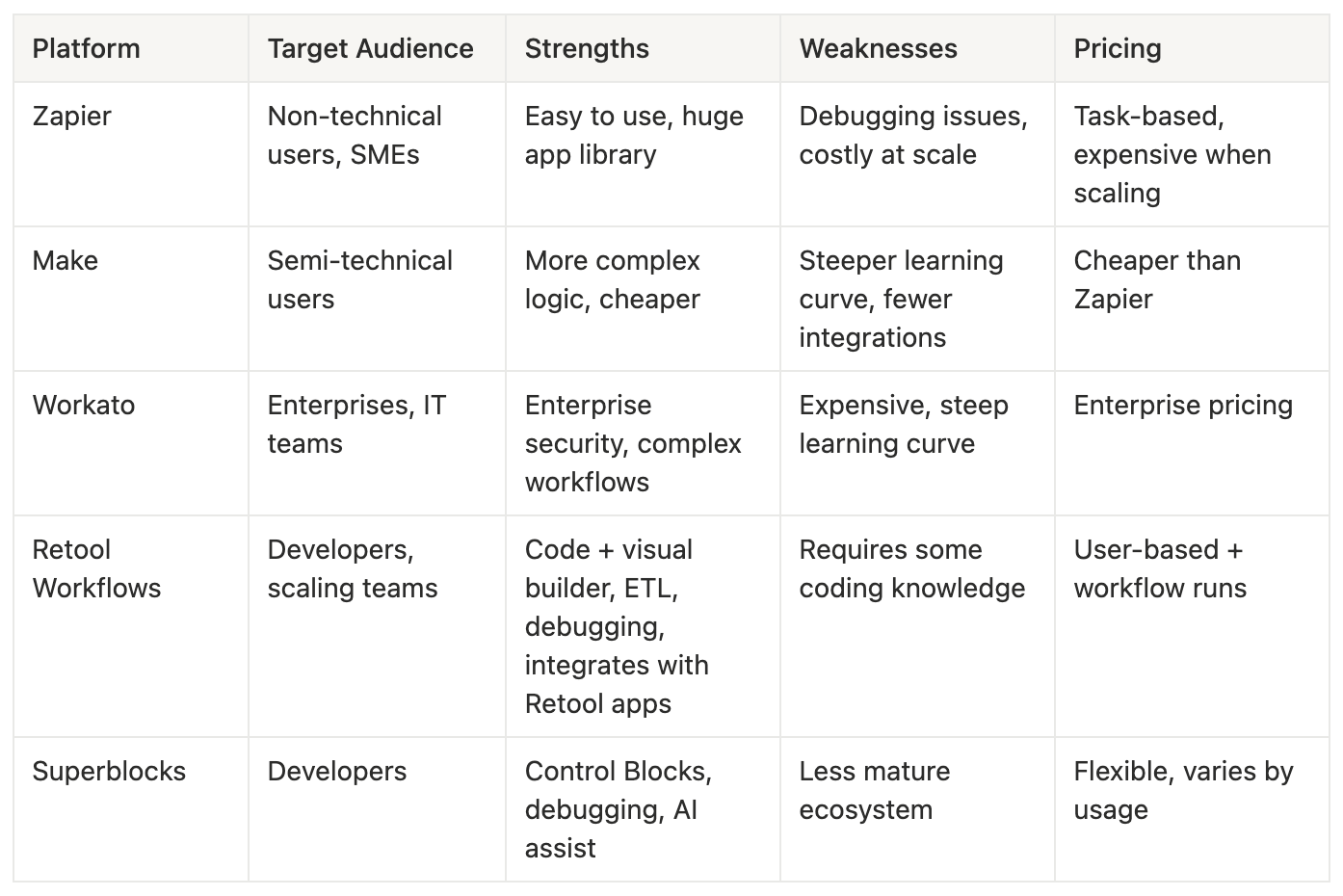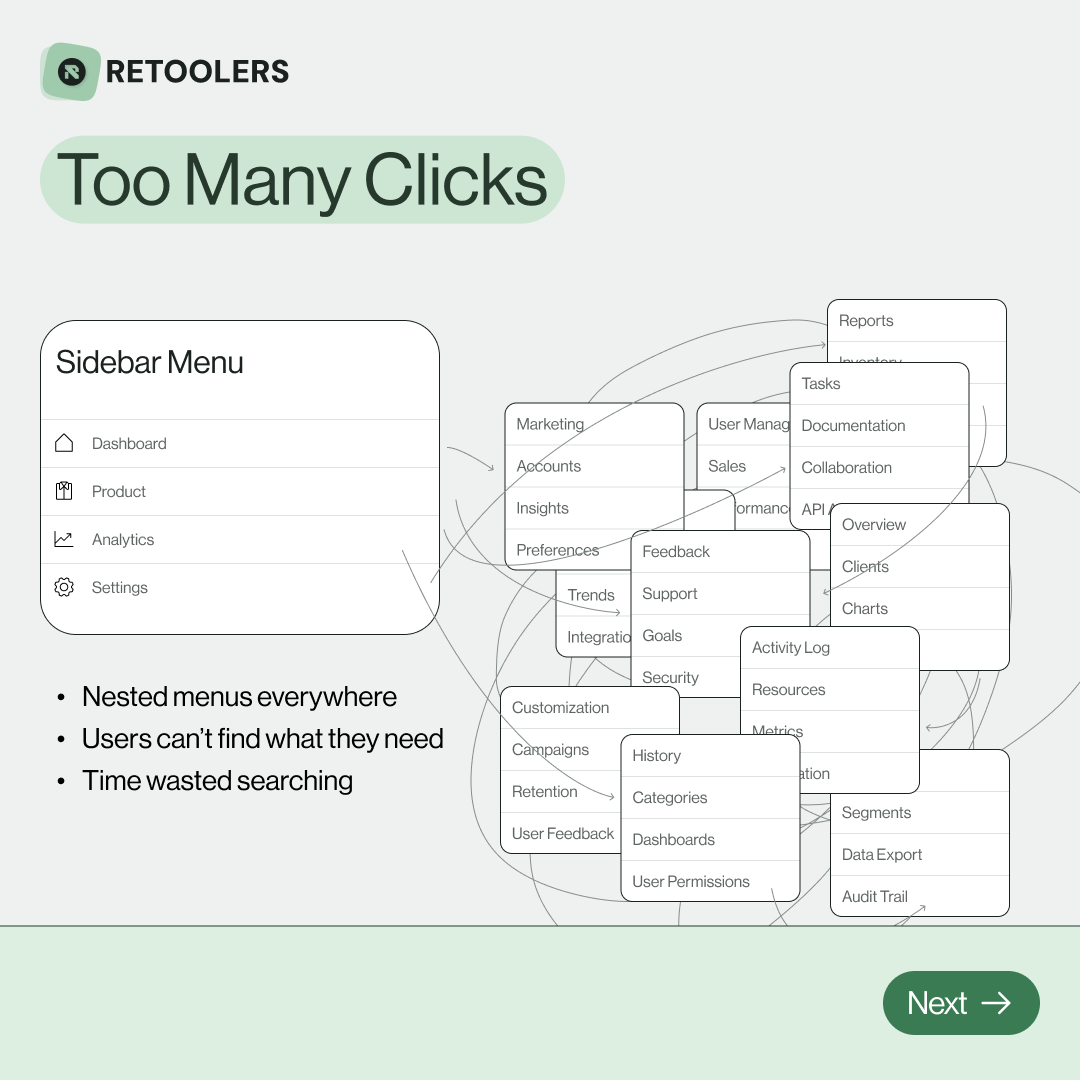Duy Vu
October 11, 2025
•
28 mins read

Budibase is an open‑source, low‑code platform for building internal tools. It aims to serve two audiences at once: developers who want to accelerate app development, and non‑technical “citizen developers” who want to build simple tools without writing code.
Budibase provides three main pillars:
The platform abstracts away coding concepts into a visual language. This makes it approachable for business users, but also introduces rigidity that developers often find limiting. Like most low‑code tools, Budibase is great for speed and accessibility, but struggles with scalability and engineering best practices.
Zapier has become the default automation tool for startups and small businesses. It’s easy to set up, integrates with thousands of apps, and empowers non‑technical users to automate repetitive tasks. But as companies scale, cracks appear:
For startups, Zapier is a quick fix. For growing teams, it becomes a liability. That’s why many engineering leaders start searching for a Zapier alternative that’s more reliable, scalable, and developer‑friendly.
Zapier isn’t useless — far from it. It’s still a great fit for:
Zapier is best thought of as a stop‑gap: fine for lightweight workflows, but not for mission‑critical infrastructure.
Zaps fail due to API changes, authentication issues, or rate limits. A single broken Zap can cascade across multiple workflows. Debugging is reactive and time‑consuming.
Case study: A SaaS startup built its sales funnel on Zapier, connecting Typeform → Salesforce → Asana → Slack → Airtable. When one Zap failed due to an expired OAuth token, leads stopped syncing to Salesforce. Sales lost visibility, marketing lost attribution data, and customer success had no prep notes. It took hours to diagnose and fix.
Zapier doesn’t support historical data, two‑way sync, or complex ETL pipelines. Conditional logic is basic, and code injection is limited. For engineers, this feels like working with handcuffs.
Zapier’s task‑based pricing looks cheap until you scale. A workflow with 10 steps firing 10,000 times a month can hit 100k tasks — costing $600/month for just one process. Multiply that across dozens of automations, and costs spiral.
If you’re evaluating Zapier competitors, Make is usually the first name that comes up. Both are no‑code automation platforms, but there are differences:

If you’re comparing Zapier vs Make, the choice comes down to priorities: Zapier for simplicity, Make for more control. But both remain no‑code tools with inherent scalability limits.
When evaluating Workato vs Zapier, the contrast is clear:
Workato is a strong Zapier alternative for enterprises that need compliance, security, and scale. But for many mid‑market teams, the cost and complexity can be prohibitive.
For most companies, the real gap lies between Zapier’s simplicity and Workato’s enterprise heft. That’s where developer‑first platforms come in — tools that combine speed with engineering best practices.
Retool Workflows lets developers build automations visually, but with the ability to drop into JavaScript or Python when needed. Key advantages:
Retool is more than just a Zapier alternative — it’s part of a full developer platform for internal tools. That means your automations, dashboards, and admin panels all live in one ecosystem.
Superblocks offers a similar developer‑first approach, with “Control Blocks” for backend logic and built‑in debugging. It’s a solid option, though less mature than Retool.

Here’s how we recommend thinking about automation tiers:
This layered approach ensures you balance speed, cost, and reliability.
For developers, Retool Workflows is the best Zapier alternative. It combines speed with engineering best practices, supports ETL, and integrates directly with internal tools.
The main Zapier competitors are Make (Integromat), Workato, Retool Workflows, and Superblocks. Each targets a different audience: non‑technical users, enterprises, or developers.
In the Workato vs Zapier debate, Workato wins for enterprises that need compliance, security, and scale. Zapier is better for small teams and non‑technical users.
Zapier charges per “task” (every action in a workflow). As workflows scale, task counts explode, making Zapier costly compared to developer‑first tools.
Not effectively. Zapier isn’t built for large‑scale ETL. Developer‑first tools like Retool Workflows or Superblocks are better suited.
Zapier is a great starting point, but it’s not where you want to build your company’s automation backbone. As you scale, you’ll need to evaluate Zapier competitors that offer more reliability, developer‑friendliness, and enterprise features.
At Retoolers, we believe the future of automation isn’t no‑code vs code — it’s developer‑first platforms that give engineers the speed of low‑code without sacrificing scalability.
Stop wasting hours on scattered tools. Let Retoolers build your custom dashboard and streamline your operations today. Book a call with us!
Looking to supercharge your operations? We’re masters in Retool and experts at building internal tools, dashboards, admin panels, and portals that scale with your business. Let’s turn your ideas into powerful tools that drive real impact.
Curious how we’ve done it for others? Explore our Use Cases to see real-world examples, or check out Our Work to discover how we’ve helped teams like yours streamline operations and unlock growth.

🔎 Internal tools often fail because of one simple thing: Navigation.
Too many clicks, buried menus, lost users.
We broke it down in this 4-slide carousel:
1️⃣ The problem (too many clicks)
2️⃣ The fix (clear navigation structure)
3️⃣ The Retool advantage (drag-and-drop layouts)
4️⃣ The impact (happier teams)
💡 With Retool, you can design internal tools that are easy to use, fast to build, and simple to maintain.
👉 Swipe through the carousel and see how better UX = better productivity.
📞 Ready to streamline your tools? Book a call with us at Retoolers.

🚀From idea → app in minutesBuilding internal tools used to take weeks.
Now, with AI App Generation in Retool, you can describe what you want in plain English and let AI do the heavy lifting.
At Retoolers, we help teams move faster by combining AI + Retool to create tools that actually fit their workflows.
👉 Check out our blog for the full breakdown: https://lnkd.in/gMAiqy9F
As part of our process, you’ll receive a FREE business analysis to assess your needs, followed by a FREE wireframe to visualize the solution. After that, we’ll provide you with the most accurate pricing and the best solution tailored to your business. Stay tuned—we’ll be in touch shortly!



